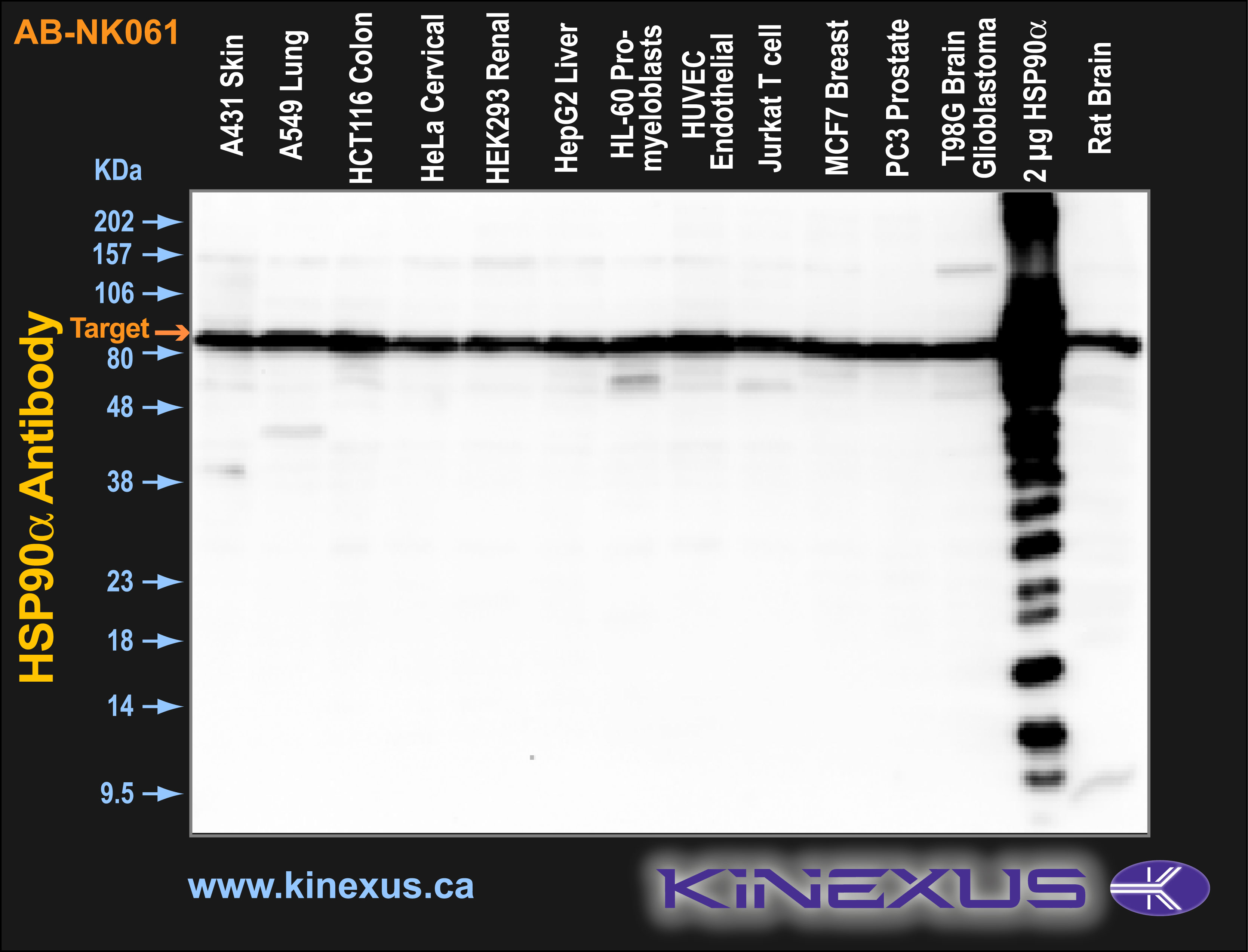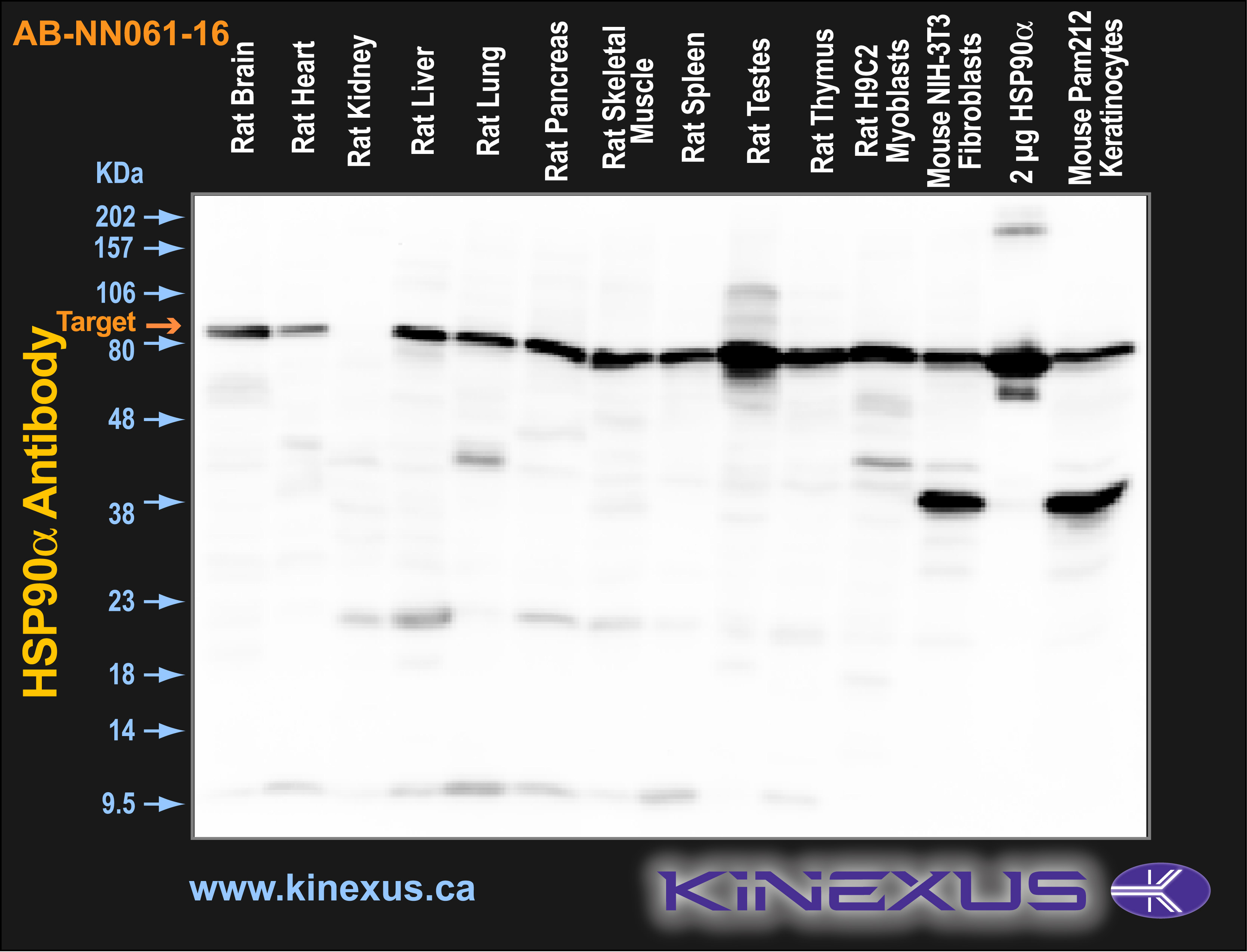Product Name: HSP90
Product Number: AB-NN061-16
| Size: | 25 µl | Price: | 89.00 | |
| $US |
Target Full Name: Heat shock protein HSP 90-beta
Target Alias: Hsp84; Hsp86; Hsp90A; Hsp90AA1; Hsp90AB1; Hsp90B; HspC1; HspC2; HspCAL1; HspCAL4; Hsp90N
Product Type Specific: Heat shock/stress protein pan-specific antibody
Antibody Code: NN061-16
Antibody Target Type: Pan-specific
Protein UniProt: P08238
Protein SigNET: P08238
Antibody Type: Polyclonal
Antibody Host Species: Rabbit
Antibody Immunogen Source: Full length human protein Hsp90
Production Method: Rabbit antiserum
Target Alias: Hsp84; Hsp86; Hsp90A; Hsp90AA1; Hsp90AB1; Hsp90B; HspC1; HspC2; HspCAL1; HspCAL4; Hsp90N
Product Type Specific: Heat shock/stress protein pan-specific antibody
Antibody Code: NN061-16
Antibody Target Type: Pan-specific
Protein UniProt: P08238
Protein SigNET: P08238
Antibody Type: Polyclonal
Antibody Host Species: Rabbit
Antibody Immunogen Source: Full length human protein Hsp90
Production Method: Rabbit antiserum
Antibody Modification: Unconjugated. Contact KInexus if you are interest in having the antibody biotinylated or coupled with fluorescent dyes.
Storage Buffer: Rabbit antiserum
Storage Conditions: For long term storage, keep frozen at -40°C or lower. Stock solution can be kept at +4°C for more than 3 months. Avoid repeated freeze-thaw cycles.
Product Use: Western blotting, ELISA, Immunoprecipitation, Immunohistochemistry, Immunofluorescence
Antibody Dilution Recommended: 1:20,000-40,000 (ECL) (WB)
Antibody Potency: Detects a ~90 kDa proteins corresponding to the molecular mass of Hsp90α/β.
Antibody Species Reactivity: Human, Rat, Mouse
Storage Buffer: Rabbit antiserum
Storage Conditions: For long term storage, keep frozen at -40°C or lower. Stock solution can be kept at +4°C for more than 3 months. Avoid repeated freeze-thaw cycles.
Product Use: Western blotting, ELISA, Immunoprecipitation, Immunohistochemistry, Immunofluorescence
Antibody Dilution Recommended: 1:20,000-40,000 (ECL) (WB)
Antibody Potency: Detects a ~90 kDa proteins corresponding to the molecular mass of Hsp90α/β.
Antibody Species Reactivity: Human, Rat, Mouse
Antibody Positive Control: A 1:40000 dilution of SPC-104 was sufficient for detection of 0.2mg of purified hsp90 by ECL immunoblot analysis.
Related Product 1: HSP90 complex pan-specific antibody (Cat. No.: AB-NN061-18)
Related Product 2: HSP90 alpha pan-specific antibody (Cat. No.: AB-NN061-19)
Related Product 3: HSP90 alpha/beta pan-specific antibody (Cat. No.: AB-NN061-2)
Related Product 4: HSP90 pan-specific antibody (Cat. No.: AB-NN061-3)
Related Product 5: HSP90 pan-specific antibody (Cat. No.: AB-NN061-4)
Related Product 6: HSP90 (total) pan-specific antibody (Cat. No.: AB-NN061-9)
Related Product 7: HSP90 alpha pan-specific antibody (Cat. No.: AB-NN164)
Related Product 1: HSP90 complex pan-specific antibody (Cat. No.: AB-NN061-18)
Related Product 2: HSP90 alpha pan-specific antibody (Cat. No.: AB-NN061-19)
Related Product 3: HSP90 alpha/beta pan-specific antibody (Cat. No.: AB-NN061-2)
Related Product 4: HSP90 pan-specific antibody (Cat. No.: AB-NN061-3)
Related Product 5: HSP90 pan-specific antibody (Cat. No.: AB-NN061-4)
Related Product 6: HSP90 (total) pan-specific antibody (Cat. No.: AB-NN061-9)
Related Product 7: HSP90 alpha pan-specific antibody (Cat. No.: AB-NN164)
Related Product 8: HSP90 beta pan-specific antibody (Cat. No.: AB-NN165)
Related Product 9: Hsp90 beta pan-specific antibody (Cat. No.: AB-NN165-1)
Related Product 10: HSP90AB1-pY484 phosphosite-specific antibody (Cat. No.: AB-PN520)
Related Product 9: Hsp90 beta pan-specific antibody (Cat. No.: AB-NN165-1)
Related Product 10: HSP90AB1-pY484 phosphosite-specific antibody (Cat. No.: AB-PN520)
Scientific Background: Hsp90 is a highly conserved and essential stress protein that is expressed in all eukaryotic cells. From a functional perspective, hsp90 participates in the folding, assembly, maturation, and stabilization of specific proteins as an integral component of a chaperone complex (1-4). Despite its label of being a heat-shock protein, hsp90 is one of the most highly expressed proteins in unstressed cells (1–2% of cytosolic protein). It carries out a number of housekeeping functions – including controlling the activity, turnover, and trafficking of a variety of proteins. Most of the hsp90-regulated proteins that have been discovered to date are involved in cell signaling (5-6). The number of proteins now know to interact with Hsp90 is about 100. Target proteins include the kinases v-Src, Wee1, and c-Raf, transcriptional regulators such as p53 and steroid receptors, and the polymerases of the hepatitis B virus and telomerase.5. When bound to ATP, Hsp90 interacts with co-chaperones Cdc37, p23, and an assortment of immunophilin-like proteins, forming a complex that stabilizes and protects target proteins from proteasomal degradation. >In most cases, hsp90-interacting proteins have been shown to co-precipitate with hsp90 when carrying out immunoadsorption studies, and to exist in cytosolic heterocomplexes with it. In a number of cases, variations in hsp90 expression or hsp90 mutation has been shown to degrade signaling function via the protein or to impair a specific function of the protein (such as steroid binding, kinase activity) in vivo. Ansamycin antibiotics, such as geldanamycin and radicicol, inhibit hsp90 function (7).
Figure 1. Immunoblotting of various cell lines with AB-NN061-16 antibody at a 1000 X dilution. The target protein HSP90a is indicated. Each lane was loaded with 15 µg of cell lysate protein. The max signal count was 65535.
Figure 2. Immunoblotting of various tissue lines with AB-NN061-16 at a 1000 X dilution. The target protein HSP90a is indicated. Each lane was loaded with 15 µg of tissue lysate protein. The max signal count was 65532.
References
[1] Arlander S.J.H. et al. (2003) J Biol Chem 278: 52572-52577.
[2] Pearl H. et al. (2001) Adv Protein Chem 59:157-186.
[3] Neckers L. et al. (2002) Trends Mol Med 8:S55-S61.
[4] Pratt W., Toft D. (2003) Exp Biol Med 228:111-133.
[5] Pratt W., Toft D. (1997) Endocr Rev 18: 306–360.
[6] Pratt W.B. (1998) Proc Soc Exptl Biol Med 217: 420–434.
[7] Whitesell L. et al. (1994) Proc Natl Acad Sci USA 91: 8324– 8328.
[1] Arlander S.J.H. et al. (2003) J Biol Chem 278: 52572-52577.
[2] Pearl H. et al. (2001) Adv Protein Chem 59:157-186.
[3] Neckers L. et al. (2002) Trends Mol Med 8:S55-S61.
[4] Pratt W., Toft D. (2003) Exp Biol Med 228:111-133.
[5] Pratt W., Toft D. (1997) Endocr Rev 18: 306–360.
[6] Pratt W.B. (1998) Proc Soc Exptl Biol Med 217: 420–434.
[7] Whitesell L. et al. (1994) Proc Natl Acad Sci USA 91: 8324– 8328.
© Kinexus Bioinformatics Corporation 2017



